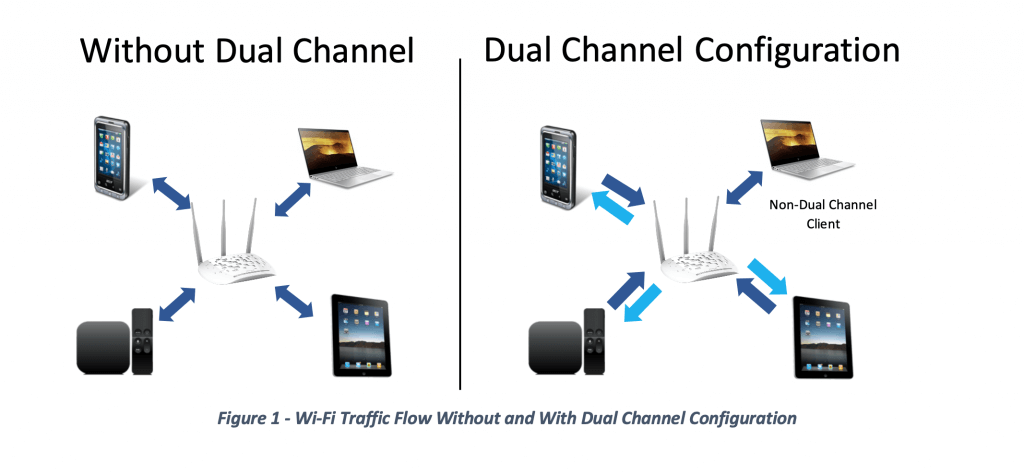Wireless
Wi-Fi: The Unsung Hero of Broadband

Key Points
- More Wi-Fi networks are being deployed to meet the growing need for better broadband connections.
- WFA Passpoint and WBA OpenRoaming have helped expand the public Wi-Fi network footprint.
We hear a lot about 5G/6G mobile and 10G cable these days, but another technology is also helping lead the pack to much less fanfare. It’s a technology that’s as essential as the public utilities you rely on every day. In fact, you’re most likely using it to read this blog post.
Why Wi-Fi? Why Now?
Evolving Wi-Fi Network Applications
Frameworks for a Wider Wi-Fi Network Footprint
Wireless
Enriched Wi-Fi Performance Through Wi-Fi Multimedia

Key Points
- A collaboration between CableLabs and Meta found that Wi-Fi Multimedia (WMM) could improve the performance of voice/video calling applications when it is enabled on an access point.
- Given the positive results from the testing, operators might consider using WMM to ensure the necessary throughput, low latency and managed jitter for time-sensitive applications such as these.
- The details of the testing and results are included in a technical report available for download below.
Network service providers and application developers both work to provide their users with the best possible quality of experience (QoE) for their respective services. Although many segments of the service/application layer of end-to-end networks are out of the operator’s control, the segments between the user’s device and the internet are not.
Wi-Fi Multimedia in Test Scenarios
Reporting on WMM Testing Results
Wireless
Finding Solutions to Randomized Wi-Fi MAC Addresses

As Wi-Fi device and OS vendors move to implement Randomized and Changing MAC Address (RCM) to reduce or eliminate the ability to track users and their devices, related functionality costs on the Wi-Fi industry are emerging. This blog will discuss how the industry is enhancing users’ privacy while working to maintain legitimate functions that require a stable means of device identification. It will wrap up by discussing the effects of RCM on beneficial tools and industry efforts to address those impacts through innovation and new technology development.
Functionality Impacts of Wi-Fi MAC Randomization
The Wi-Fi Industry’s Solutions
Get Involved
Wireless
Bringing Wi-Fi Security to the Next Level

WBA PKI Framework Enables RadSec Connection Security
Wireless
WBA OpenRoaming™ to Enable Global Wi-Fi Roaming

On May 28, 2020, the Wireless Broadband Alliance (WBA) announced the launch of OpenRoaming. OpenRoaming is a cloud federation–based framework that will open Wi-Fi roaming to a broad community of Identity Providers (IDPs) and Access Network Providers (ANPs). OpenRoaming is a cyber-secured, seamless connection and automatic RADIUS router all rolled into one global multi-provider ecosystem. The fundamental makeup of OpenRoaming spans multiple technologies: Passpoint, DNS Discovery, RadSec and components of the Wireless Roaming Intermediary eXchange (WRIX).
Why OpenRoaming?
Wireless
RadSec, Securing RADIUS Message Exchange

With the ever-increasing use of mobile devices for data-rich activities, mobile networks have felt the burden of handling larger amounts of data. To gain relief, mobile operators have turned to offloading data onto Wi-Fi networks that are locally available—not only their own networks but Wi-Fi networks owned by their roaming partners. If the roaming partner’s Wi-Fi network is secured, then the subscriber’s credentials are exchanged between the roaming partner and the home operator, typically over the Internet. These credentials need to be secured while traversing the Internet, and the most common method is to use IPSec secure tunnels. Although IPSec secures and encrypts this critical information over the Internet, IPSec is not without issues and risks.
A Solution to These Issues Is RADIUS Security (RadSec)
Reliability
A Better Wi-Fi Experience with Dual Channel Wi-Fi™

At least 15 percent of customer service calls are Wi-Fi related, ranging from poor connections to video playback issues, translating to more than $600 million in annual support costs for the cable industry (in North America alone). As the Wi-Fi industry looks for ways to increase speed, coverage and support for more devices in the Wi-Fi ecosystem, one critical element has been overlooked: the need to have the necessary airtime to send data to all end devices in a timely manner. Even with faster Wi-Fi connections, if there is no available airtime to send the data, the connection is useless. CableLabs realized this shortfall and addressed it with the development of Dual Channel Wi-Fi technology.
What Is Dual Channel Wi-Fi?
Benefits of Dual-Channel Wi-Fi
Labs
Successful OnGo Interoperability Test Event Held at CableLabs

During the week of August 27th CBRS-Alliance members and government representatives gathered in Louisville Colorado at the CableLabs facility for the first CBRS OnGo™ Interoperability Test Event. The attendees consisted of a Spectrum Access System (SAS) Administrator, Citizen Band Service Device (CBSD) vendors, Domain Proxy (DP) vendors, End Unit Device (EUD) vendors and operators and representatives of various government agencies.



